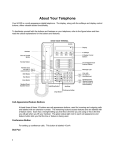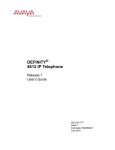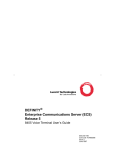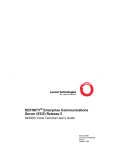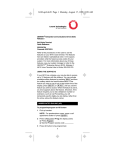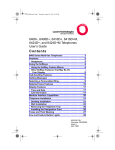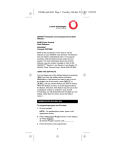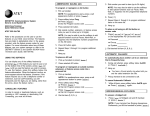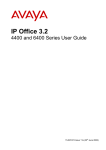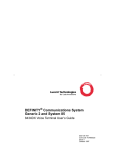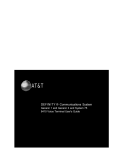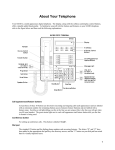Download Avaya 6408D+ 8 Button Display Telephone
Transcript
6408 - 6416 - 6424 Voice Terminal User’s manual DEFINITY G3 - Release 6.3 or later 555-230-758 Issue 1, July 2000 Disclaimer Intellectual property related to this product (including trademarks) and registered to Lucent Technologies Inc. has been transferred or licensed to Avaya Inc. Any reference within the text to Lucent Technologies Inc. or Lucent should be interpreted as references to Avaya Inc. The exception is cross references to books published prior to April 1, 2001, which may retain their original Lucent titles. Avaya Inc. formed as a result of Lucent’s planned restructuring, designs builds and delivers voice, converged voice and data, customer relationship management, messaging, multi-service networking and structured cabling products and services. Avaya Labs is the research and development arm for the company. Copyright 2000 Lucent Technologies All rights reserved Notice While reasonable efforts were made to ensure that the information in this document was complete and accurate at the time of printing, Lucent can assume no responsibility for any errors. Changes or corrections to the information contained in this document may be incorporated into future issues. Trademark information DEFINITY is a registered trademark of Lucent in the U.S. and throughout the world. Safety warning This terminal may only be connected to a DEFINITY system. 3 Your voice terminal Preset feature buttons . . . . . . . . . . . . . . . . . . . . . . . . . . . . . . . . . . . . . . . . . . . . . . . . . . . . . . . . . . . . . . . . . . . . . . . . . . . . . . . . . . . . . . 4 Using the display control buttons and softkeys . . . . . . . . . . . . . . . . . . . . . . . . . . . . . . . . . . . . . . . . . . . . . . . . . . . . . . . . . . . . . . . . . 4 Using the call appearance/feature buttons . . . . . . . . . . . . . . . . . . . . . . . . . . . . . . . . . . . . . . . . . . . . . . . . . . . . . . . . . . . . . . . . . . . . . 4 Basic features Placing a call . . . . . . . . . . . . . . . . . . . . . . . . . . . . . . . . . . . . . . . . . . . . . . . . . . . . . . . . . . . . . . . . . . . . . . . . . . . . . . . . . . . . . . . . . . . . . . 5 To automatically redial an extension that was busy or did not answer . . . . . . . . . . . . . . . . . . . . . . . . . . . . . . . . . . . . . . . . . . . . . . . . . 5 Placing a call on hold and returning to it . . . . . . . . . . . . . . . . . . . . . . . . . . . . . . . . . . . . . . . . . . . . . . . . . . . . . . . . . . . . . . . . . . . . . . . 5 Transferring a call . . . . . . . . . . . . . . . . . . . . . . . . . . . . . . . . . . . . . . . . . . . . . . . . . . . . . . . . . . . . . . . . . . . . . . . . . . . . . . . . . . . . . . . . . . 5 Setting up a conference call . . . . . . . . . . . . . . . . . . . . . . . . . . . . . . . . . . . . . . . . . . . . . . . . . . . . . . . . . . . . . . . . . . . . . . . . . . . . . . . . . 6 To drop the last party added to a conference call . . . . . . . . . . . . . . . . . . . . . . . . . . . . . . . . . . . . . . . . . . . . . . . . . . . . . . . . . . . . . . . . . 6 Sending or redirecting your calls . . . . . . . . . . . . . . . . . . . . . . . . . . . . . . . . . . . . . . . . . . . . . . . . . . . . . . . . . . . . . . . . . . . . . . . . . . . . . 6 To send all calls immediately to coverage. . . . . . . . . . . . . . . . . . . . . . . . . . . . . . . . . . . . . . . . . . . . . . . . . . . . . . . . . . . . . . . . . . . . . . . 6 To temporarily redirect all calls to an extension or outside number . . . . . . . . . . . . . . . . . . . . . . . . . . . . . . . . . . . . . . . . . . . . . . . . . . . 7 Advanced features Programming an AD softkey . . . . . . . . . . . . . . . . . . . . . . . . . . . . . . . . . . . . . . . . . . . . . . . . . . . . . . . . . . . . . . . . . . . . . . . . . . . . . . . . . 8 Programming an AD button . . . . . . . . . . . . . . . . . . . . . . . . . . . . . . . . . . . . . . . . . . . . . . . . . . . . . . . . . . . . . . . . . . . . . . . . . . . . . . . . . . 8 Programming an AD personal list item . . . . . . . . . . . . . . . . . . . . . . . . . . . . . . . . . . . . . . . . . . . . . . . . . . . . . . . . . . . . . . . . . . . . . . . . 9 To place a call using an AD list button . . . . . . . . . . . . . . . . . . . . . . . . . . . . . . . . . . . . . . . . . . . . . . . . . . . . . . . . . . . . . . . . . . . . . . . . . 9 Programming a feature onto an available button . . . . . . . . . . . . . . . . . . . . . . . . . . . . . . . . . . . . . . . . . . . . . . . . . . . . . . . . . . . . . . . 10 Answering a call placed to a coworker unable to answer . . . . . . . . . . . . . . . . . . . . . . . . . . . . . . . . . . . . . . . . . . . . . . . . . . . . . . . 10 Searching the directory for a name . . . . . . . . . . . . . . . . . . . . . . . . . . . . . . . . . . . . . . . . . . . . . . . . . . . . . . . . . . . . . . . . . . . . . . . . . . 10 Entering a call to make an important announcement . . . . . . . . . . . . . . . . . . . . . . . . . . . . . . . . . . . . . . . . . . . . . . . . . . . . . . . . . . . 11 Appendices Glossary . . . . . . . . . . . . . . . . . . . . . . . . . . . . . . . . . . . . . . . . . . . . . . . . . . . . . . . . . . . . . . . . . . . . . . . . . . . . . . . . . . . . . . . . . . . . . . . . . 12 Call purpose identifiers . . . . . . . . . . . . . . . . . . . . . . . . . . . . . . . . . . . . . . . . . . . . . . . . . . . . . . . . . . . . . . . . . . . . . . . . . . . . . . . . . . . . 13 Call coverage. . . . . . . . . . . . . . . . . . . . . . . . . . . . . . . . . . . . . . . . . . . . . . . . . . . . . . . . . . . . . . . . . . . . . . . . . . . . . . . . . . . . . . . . . . . . 13 Abbreviated dialing . . . . . . . . . . . . . . . . . . . . . . . . . . . . . . . . . . . . . . . . . . . . . . . . . . . . . . . . . . . . . . . . . . . . . . . . . . . . . . . . . . . . . . . 13 4 Your voice terminal Preset feature buttons Your voice terminal Speaker button: to access the Speaker (listen-only), Group listening or Speakerphone feature (listen and talk). Check with your system manager to see how your voice terminal is set. The light next to the button goes on when the feature is active. Mute button: to turn off the microphone associated with the handset or the built-in speakerphone so the other person on the call cannot hear you. The light next to the button goes on when the feature is active. Hold button: to put a call on hold until you can return to it. Redial button: to automatically redial the last number you dialed (outside, extension, trunk number or feature access code). Transfer button: • while off-hook, to transfer a call to another voice terminal. Conference button: • while off-hook, to set up a conference call of up to 6 people including yourself. • while on-hook, to test your voice terminal lights and display. • while on-hook, to select a ringing pattern for your voice terminal. Press the button repeatedly to cycle through the different patterns. After 7 seconds of no activity, the current ring pattern is saved. Note: If the message «EXPORT VERSION» is displayed, press the Transfer button while on-hook. If you experience any difficulty, contact your system manager. Volume control button: to adjust the volume of the speaker, handset receiver level and ringer. Message light: goes on when a message has been left for you. See your system manager for instructions on how to get your messages. Using the display control buttons and softkeys TmDay Timer Cpark Pause Sample feature option screen • The four display control buttons are (from left to right): - Menu for entering Softkey Mode and accessing the first feature option screen - Exit for exiting the Softkey Mode and returning to Normal Mode - Previous and Next for going back and forth through the feature option screens. • The softkeys located below the display are used along with display control buttons to access features. If a feature is active, an arrow appears above the feature abbreviation. The display gives you call-related information for incoming calls. When the call is from a system user, the display shows the caller’s name and extension number. When the call is from outside the system, the display shows the calling party’s number. Using the call appearance/feature buttons Call b In most cases 3 of these buttons are devoted to incoming and outgoing calls (call appearances). The remaining buttons can also be call appearance buttons or they can access additional features (feature buttons). The features are administered on the call appearance/feature buttons by your system manager. Call c Each of these buttons has a red light and a green status light. Call a Program AD entry Sample labelled card To install the designation card on your terminal, unsnap the plastic cover and lift off. Green status light next to a button Off Steadily on Flashing Slow Flash Intermittent Flash feature button extension button call appearance Off Idle Idle Active Busy Busy — — Incoming call — — Held call Invalid — — The red light tells you this is the line you are using or this is the line you will get when you go off–hook. Basic features 5 Placing a call Basic features 1. 2. 3. Press the Speaker button or the Headset button if you are using a headset. Dial the extension or telephone number (If applicable, dial the outdial code before the telephone number). Press the Speaker button or the Headset button to end the call. Headset or 1 r be m Nu 1 2 Headset 3 or 3 To automatically redial an extension that was busy or did not answer This feature sends you a ring indicating that a previously busy or unanswered extension is now available. 1. Press the softkey below AutCB or the AutoCallBk button. mDay AutCB Pause AutoCallBk 1 or 1 To cancel Automatic Callback : press the softkey below AutCB or the AutoCallBk button. Automatic Callback is automatically canceled after 30 minutes. Placing a call on hold and returning to it 1. 2. Press the Hold button. To return to the held call, press the call appearance button of the held call. Call 1 2 Transferring a call 1. 2. 3. Press the Transfer button. Dial the number where the call is to be transferred. Press the Transfer button again. r be m Nu 1 2 3 If no answer or busy, return to held call by pressing the appropriate call appearance button. 6 Basic features Setting up a conference call 1. 2. 3. Press the Conference button. Dial the number of the new party and wait for answer or press the call appearance button of call on hold. Press the Conference button again. Repeat steps 1 - 3 for additional conference connections (for a total of up to 6 people). r be m Nu Call or 2 1 2 To drop the last party added to a conference call 1. mDay 3 Press the softkey below Drop or the Drop button. Drop Pause Drop 1 or 1 Sending or redirecting your calls To send all calls immediately to coverage 1. 2. Press the Speaker button. Press the softkey below SAC or the Send Calls button (or dial the Send All Calls access code*). mDay SAC Pause Send Calls or 2 1 2 To cancel Send All Calls: 1. Press the Speaker button. 2. Press the softkey below SAC or the Send Calls button again (or dial the Send All Calls cancel code*). mDay SAC Pause Send Calls 1 2 or *Check with your system manager to see which features are available to you. 2 Basic features 7 To temporarily redirect all calls to an extension or outside number 1. 2. 3. Press the Speaker button. Press the softkey below CFrwd or the Call Fwd button (or dial the Call Forward access code*). Dial the extension or telephone number where calls will be sent. mDay CFrwd m Nu Call Fwd or 2 1 r be Pause 2 3 To cancel Call Forwarding: 1. Press the Speaker button. 2. Press the softkey below CFrwd or the Call Fwd button again (or dial the Call Forward cancel code*). mDay Pause CFrwd Call Fwd 1 2 or *Check with your system manager to see which features are available to you. 2 8 Advanced features Programming an AD softkey Advanced features 1. 2. 3. 4. 5. 6. 7. 8. 9. mDay Press the softkey below Prog or the Program button (or dial the AD Program access code*). Press the Menu button. Press the softkey to be programmed. Dial 1 to confirm you want to enter a new number or change an existing number. Dial the outside number, extension or feature access code you want to store (up to 16 or 24 digits)*. Press . Dial 1 to confirm you want to change the label for that softkey. Enter a label for the softkey using the dialpad (up to 5 characters). Press the Speaker button to end programming. Prog mDay Pause AD2 Pause Program or 1 1 2 3 r be m Nu 4 l be La 6 5 7 8 9 Programming an AD button 1. 2. 3. 4. 5. mDay Press the softkey below Prog or the Program button (or dial the AD Program access code*). Press the feature button to be programmed. Dial the outside number, extension or feature access code you want to store (up to 16 or 24 digits*). Press . Repeat steps 2 - 4 to program additional buttons or press the Speaker button to end programming. Prog m Nu Program 1 5 r be Pause or or 1 5 *Check with your system manager to see which features are available to you. 2 3 4 Advanced features 9 Programming an AD personal list item 1. 2. 3. 4. 5. 6. mDay Press the softkey below Prog or the Program button (or dial the AD Program access code*). Dial the Personal List number (1, 2 or 3). Dial a list item (1, 2, 3...). Dial the outside number, extension or feature access code you want to store (up to 24 digits). Press . Dial another list item to be programmed (or reprogrammed) on the same list and repeat steps 5 - 6 or press the Speaker button to end programming. Prog tn Program 1 or Lis 1 t Lis 2 er em t it b um N Lis 3 4 m ite 6 5 er b um Pause or 6 To place a call using an AD list button 1. 2. 3. Press the Speaker button. Press the Pers List or Grp List or Sys List or Enhcd List button (or dial the appropriate AD List access code*). Dial the desired list item (1, 2, 3...). t Lis AD ..... 1 2 m ite 3 AD buttons holding complete phone numbers and/or feature access codes may be assigned by your system manager. These numbers and/or codes are necessarily AD list items. Remember that numbers on a personal list are programmable by you whereas numbers on group and system lists are programmable only by the system manager. *Check with your system manager to see which features are available to you. 10 Advanced features Programming a feature onto an available button The following features may be programmed on buttons: Account Code Entry (Acct), Automatic Dialing (AutoD), Call Forward (CFrwd), Call Park (Cpark), Call Pickup (CPkUp), Directed Call Pickup (DPkUp), Group page (GrpPg), Send All Calls (SAC), Whisper Page (WspPg), Whisper Page Answer (WspAn) and Whisper Page Off (WsOff). 1. Press the softkey below Admin. 2. Enter your security code when required. 3. Press the softkey below Done when the security code is entered. 4. Press the softkey below the feature you want to program into an available button (CPkUp for instance). 5. Press the softkey below Expl? to display the full name. 6. Press the softkey below Selct to select the feature. 7. Press the feature button to be programmed. 8. Press the softkey below Cont if you want to program another button or press the Exit button to end self-administration and return to call-handling mode. mDay Admin Pause e od SECURITY CODE: Done C 2 1 Call Pickup ShortMode? mDay 3 CPkUp Pause mDay Expl? 4 5 BUTTON PROGRAMMED! Next Selct Cont 7 6 or 8 8 Answering a call placed to a coworker unable to answer 1. 2. 3. Press the Speaker button. Press the DirCall PkUp button (or dial the Directed Call Pickup access code*). Dial the extension number of the ringing voice terminal. er b um N DirCall PkUp 2 1 3 Searching the directory for a name 1. 2. 3. 4. mDay Press the softkey below Dir or the Directory button. Enter the name using dial pad keys. Press 2 for «ABC», 3 for «DEF», etc.… Use to enter a comma or a space. For example : Press «7, 2, 6, 8, 8, and 7» to search for «SCOTT R». Press the Next button for the next directory name you wish to see. While name is shown, press the Call Disp button to place a call to your coworker. Dir Pause me 1 or Call Disp Na Directory 1 *Check with your system manager to see which features are available to you. 2 3 4 Pause Advanced features 11 Entering a call to make an important announcement 1. 2. 3. Dial the extension number. Press the Whisper Page button (or dial the Whisper Page access code*) when you hear the busy tone. Make the announcement to your coworker. er b um N 1 Whisper Page 2 The parties on the call hear a beep. Only your coworker hears the announcement. *Check with your system manager to see which features are available to you. 12 Appendices Glossary Appendices This glossary shows many of the features offered by DEFINITY. Check with your system manager to see what features you can use. Underlined feature names or abbreviations are those that may be seen on the option screens. Abbreviated Dialing Use as a timesaver for dialing frequently called, lengthy or emergency numbers. This feature may be on a button, a softkey or a list - personal, group and system (page 8). Answer Back Use this code to retrieve a parked call from any extension. Automatic Callback AutCB Use to avoid constant redialing when you wish to speak to someone who is frequently busy on the telephone or in and out of the office (page 5). Automatic Intercom IAuto Use to rapidly dial frequently called numbers. You can call a predetermined partner by pressing the feature button. Button View BtnVu Use to verify features programmed in buttons, AD list items or last number dialed before placing a call or reprogramming a number. Press softkey or feature button then follow the described procedure (pages 5 and 8). Call display Use to place a call to the coworker whose name is shown on the display (page 10) or to return a call to a message sender. Call Forwarding CFrwd Use when you will be away from your voice terminal and you want your calls to be forwarded to a telephone number of your choice (page 7). Call Park CPark Use when you need to go elsewhere to get information during a call, or whenever you wish to complete a call from a different location. Call Pickup CPkUp Use when you wish to handle a call for a member of your pickup group who is absent or otherwise unable to answer. Directed Call Pickup DPkUp Use to pick up a call ringing at a specific extension without being a member of the person’s pickup group. Directory Dir Use as a handy quick reference source for extension number information (page 10). Drop Use whenever you want to continue using the handset after ending a call or disconnect the last party added to a conference call (page 6). Exit Use to leave Softkey Mode and return to Normal (call-handling) Mode (page 4). Group listen Use in group listening situations. The handset and speaker are active at the same time (page 4). Group Page GrpPg Use to page several coworkers at the same time through the voice terminals’ built-in speaker. Headset Use to answer, place or disconnect from a call when you are using a headset instead of a handset (page 5). Hold Use when you have a call you don’t want to drop, but have to interrupt briefly to do something else such as place another call, activate another feature or answer a waiting call (page 5). Inspect Inspt Use to identify and screen new calls. Press feature button then call appearance button of the new call. Internal (Hands Free) Auto Answer HFAns Use any time you prefer internal hands-free communication (Your telephone produces a warning tone and your speakerphone is automatically turned on). Last Number Dialed Last Use to save time in redialing a busy or unanswered number (page 4). CnLWC Leave Word Calling LWC Use whenever you wish to have someone call you back ; it helps cut down on repeated call attempts. Conference Allows you to conference up to six parties on a call (including yourself) so you can conduct a 6-way discussion (page 6). Manual Exclusion (Bridging) Excl Use to keep other users with whom you have a bridged call appearance from listening in on an existing call. Consult Cnslt Use to call the principal (the person for whom you are answering calls) for private consultation after answering a coverage call. Mark (Abbreviated Dialing) Mark Numbers included after a Mark in an AD number are dialed in Touch-Tone signal form. Cover message retrieval Use to see coworker’s messages. Menu Use to enter Softkey Mode and access the first feature option screen (page 4). Cancel Leave Word Calling Use to cancel Leave Word Calling Date/Time TmDay Use as a handy calendar and clock. Press softkey or feature button. Dial Intercom IDial Use to rapidly dial frequently called numbers. You can call any member of a predetermined group of users. Press softkey or feature button then dial the group member’s code. Message Light which goes on when a caller has left a message for you (page 4). Message Retrieval Use to quickly and conveniently check messages (when your Message light is on), even when you are already on a call. Appendices 13 Mute Use when you want to confer with someone in the room with you, but you do not want the other person on the call to hear your conversation (page 4). Wait (Abbreviated Dialing) Wait Numbers included after a Wait in an AD number are delayed 5 to 25 seconds until the voice terminal receives dial tone from the switch. Next Use to go forth through the softkey feature screens (page 4). Whisper Page WspPg Use to make an announcement to a person at another extension currently on another call (page 11). Pause (Abbreviated Dialing) Pause Use to place a 1.5-second pause in an AD number (such as between an outdial code and a telephone number). Previous Use to go back through the softkey feature screens (page 4). Program (Abbreviated Dialing) Prog Use to program a telephone number, extension or feature access code in an AD personal list, an AD button or an AD softkey (pages 8 and 8). Ringer off RngOf Use any time you choose not to have your phone ring when you have an incoming call (you will nevertheless hear a shortened ring). Select Ring Use to help distinguish your incoming calls from those of the other nearby voice terminals (page 4). Self-Administration Admin Use to program selected features into your voice terminal feature buttons using the softkeys and display control buttons (page 10). Send All Calls SAC Use when you will be away from your desk for a while or when you do not wish to be interrupted by telephone calls (page 6). Speaker feature (listen-only) Use for on-hook dialing (page 4). Speakerphone (speak and listen) Use any time you prefer hands-free communication, both speaking and listening, or for group conference situations (page 4). Suppress (Abbreviated Dialing) Spres Use for passwords or authorization codes. Suppressed numbers are dialed but not shown on the display (an «s» appears instead). Stop/Indefinite Wait (Abbreviated Dialing) Stop When the switch detects a Stop programmed in an AD number, it stops dialing until it detects a new dial tone. Test Use to test the lights and the display on your voice terminal (page 4). Timer Timer Use to keep track of time spent on a call or task. Press softkey or feature button to start/stop the timer. Transfer Use when your caller needs to speak further with someone else (page 5). Volume control Use to raise or lower the volume of the speakerphone or speaker, handset receiver level or ringer (page 4). Whisper Page Answer Use to answer a Whisper page announcement. WspAn Whisper Page Off WsOff Use to protect an established call from being disturbed by a Whisper page announcement. Call purpose identifiers Call coverage When you are a covering user, the following identifiers may be displayed : p : Call Pickup c : Cover All Calls n : Night Station Service, Including No Answer B : All Calls Busy f : Call Forwarding b : Cover Busy d : Cover Don’t Answer s : Send All Calls. Abbreviated dialing When viewing the number stored on an AD button or as a list item, the following identifiers may be displayed : m : Mark p : Pause s : Suppress w : Wait For A Specified Time W : Wait For Off-Premise Dial Tone. The information in this document is subject to change without notice. The manufacturer assumes no responsibility for any errors that may appear in this document.














